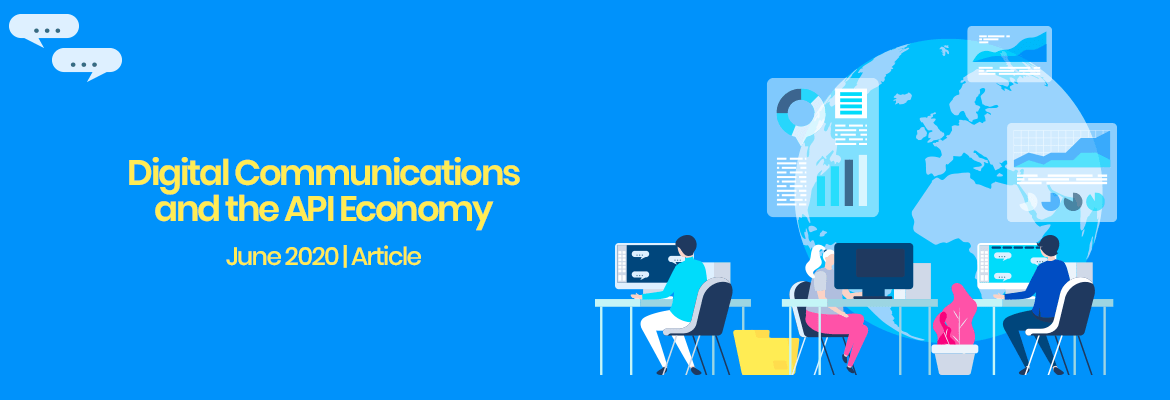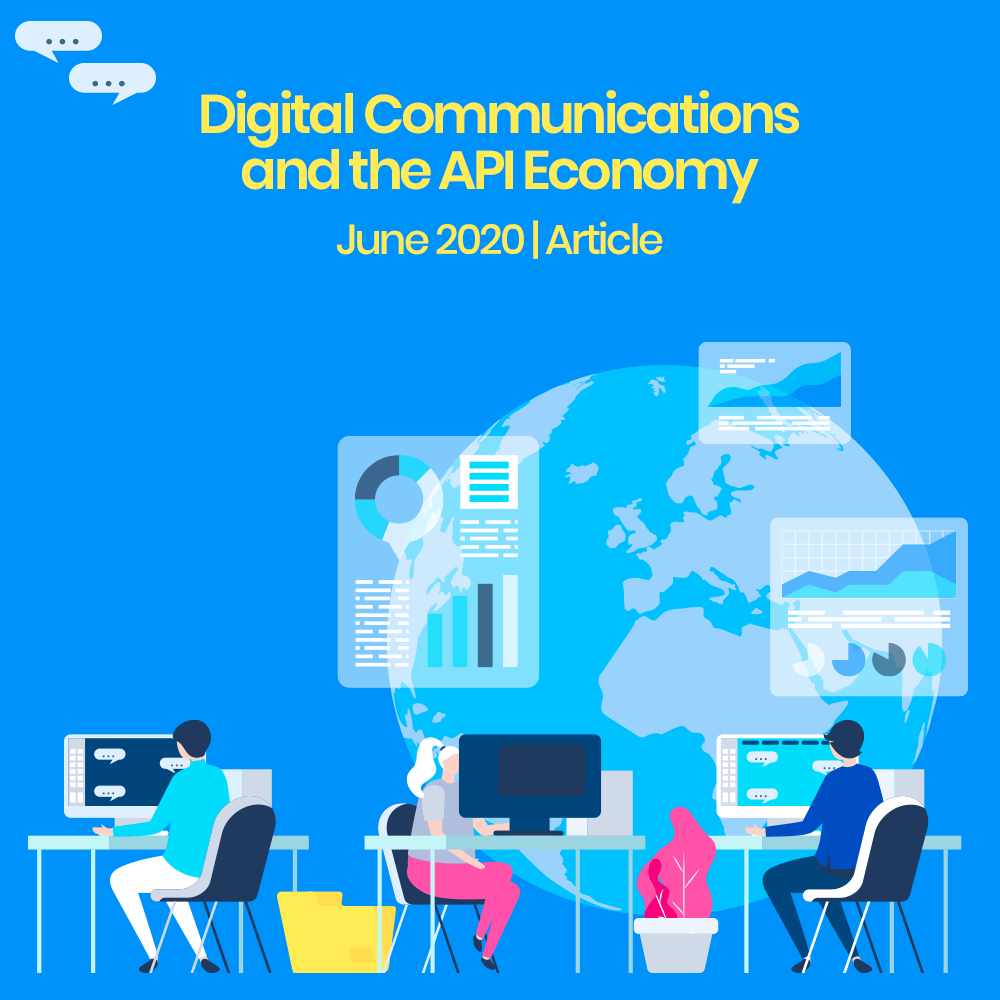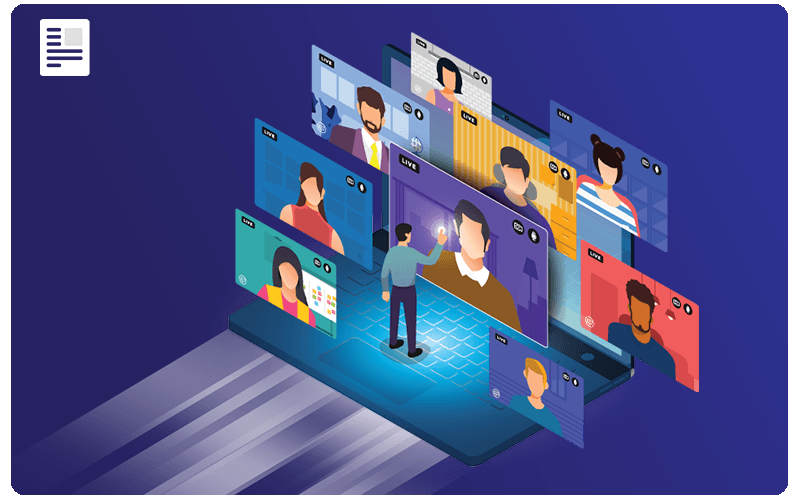

So what’s an API anyways?
Application Programming Interfaces (APIs) are the bedrock of the cloud, mobile, SaaS, Big Data and Internet of Things (IoT) digital revolution. They enable organizations to share data and applications through easily accessible standards and platforms and hence, simplify access to information and functionality. The demand for APIs stems from an intrinsic need to simplify the process of sharing information and enabling transaction processing between elements in the solution stack. APIs enable previously separate software components to successfully communicate by overcoming built-in incompatibilities created by multiple software. Although APIs have been around since the 1960s, they were quite one-directional, i.e.- basic interoperability enabled the first programmatic exchanges of information and network protocols were interconnected. Since Web APIs, those that are publicly available, took off in the early 2000s and exploded with the digital disruption, many industries have been able to have the opportunity to create a thriving platform offering across an ecosystem. The API directory ProgrammableWeb, revealed that the number of Web APIs has grown 1000% this decade alone.
The nature (and impact) of APIs require them to be regarded as products; the way they are carefully crafted and designed so they can not only seem attractive and marketed to potential customers better, but can be customized according to the needs of businesses and the models they help enable. A typical customer of API is a software developer but the reality is that their business impact is a lot more. The function of APIs has been upgraded from being merely a development technique to a business model driver; one that reuses, shares and monetizes an organization’s assets. The executive leadership of any present-day organization should get to know this acronym well. In 2008, Netflix introduced their first public API and since then they have gone from offering streaming services on a small number of devices to supporting their growing subscriber base on more than 1000 different devices. Today, a tool that was once reserved for reaching new audiences is now being leveraged for overall business strategies as roughly 99.97% of Netflix’s API traffic is between services and devices. Imagine the big impact of this little thing.
The driving force behind APIs
Digital transformation across all sectors of enterprise organizations have shifted into high gear since the COVID-19 pandemic. Business processes are being revamped with a focus on services and capabilities that are easy to integrate, consume, and deploy. Developers need clear documentation on API audit trails, debugging, and sample code. Many APIs are available for different channels. Organizations need to find those that provide the kind of security that aligns with their organizational requirements and can scale for local, regional, or global reach. However, choosing the wrong API can risk putting an app deployment in peril if it grows from a regional to a global solution. It’s costly to fix. That’s where CPaaS comes in. These platforms manage all of the complexity of deploying and supporting APIs for each channel and integrating data, security, operational, and other services. Smaller CPaaS vendors may provide only a few APIs and don’t have global scalability. Larger CPaaS solutions like SAP Digital Interconnect are constantly looking at all the channels across different markets, adding APIs for channels, security, and many applications like CRM, digital maps, video, and contact center.
If APIs are the engine behind the digital economy, API gateways are the control panels that determine what goes in and out of this network. By using APIs, organizations can choose how they access performance and usage data, what type of data they need, and when they need it. APIs are easy to integrate with an organization’s existing tools and processes. Like a smart grid for the cloud, it ensures the flow of data is stable and secure, even at a massive scale. API gateways are among the most popular open-source technologies, according to new research from Kong/Vanson Bourne. Advanced API gateways are capable not only of moving data between organizations (e.g., connecting Alexa to Spotify), but also of managing the constant flow of business-critical information within individual organizations in a smart way, delivering automated, faster, and reliable connectivity among APIs and humans.
Communication APIs
As the name suggests, communication APIs are built for the (digital) communications space and are meant to establish standardized and systemic methods of communication across the board. They help organizations define interactions between servers and communication applications, as well as determine a data’s format and security. For instance, an organization can integrate communication APIs with existing enterprise software. Embracing this approach can enhance productivity, streamline workflows, and refine operations through leveraging data and analytics. There are various types of communications APIs that can be integrated into existing software with the ease of organizations adopting as many as they can with ease. Some of the most common types of communication APIs includes:
- SMS APIs
- Two-Way SMS API
- SIP Trunking
- Voice Calling APIs
- REST APIs
- Emergency Calling APIs
- Number Discovery
APIs and the cloud; name a better duo
An integration duo that stands out is that of APIs and the cloud. APIs have played a significant role in major cloud success stories by equipping organizations with ever-evolving communication capabilities. Calix, a leading provider of broadband communications access systems and software, used cloud integration to speed the progression and delivery of their new services such as innovative web-content management and customer portals. Third-party APIs offer customized and flexible communication features to their customer such as SMS, voice, two-factor authentication, data, VoIP and social media messengers. In fact, the global voice and text messaging markets are two parts of CPaaS stacks that are already worth billions in 2020 are expected to grow to a value of $8.2 billion by next year (2021). Google Cloud also offers Video Intelligence APIs that allow video analysis, media management, creating intelligent video apps, automating expensive workflows and also storage. The driving force for organizations transitioning from the legacy world to a cloud-based solution is the cutting-edge API integration ability. Long story short, APIs are the glue of cloud computing.
The need for APIs stems from the growth of cloud computing which has led to the need for integration. The integration of cloud computing with APIs have facilitated the creations of unique user-focused applications that ensure smooth and operationally efficient communications. It provides businesses with the opportunity to provide their customers with evolved and improved business services through web and mobile applications. A 2020 Connectivity benchmark report that surveyed 800 global IT leaders on the state of connectivity and digital transformation revealed that 35% of organizations have earned more than a quarter of their revenue as a direct result of APIs. Organizations can continue to make use of heavy amounts of data through third-party APIs to create better, faster and more personalized business services that today’s customer and employees expect. For instance, HSBC provide a single financial dashboard for their customers, opening up a variety of options (branch, phone, digital banking) for their customers to manage their personal and business finances through. The API economy has proved to be an accomplished avenue for allowing organizations to create new services and equipping them with endless capabilities, that in turn generate new revenue streams for them.
UCaaS & CPaaS
APIs have made a breakthrough in Unified Communications. Since Unified Communications as a Service (UCaaS) solutions are borderline legacy technology now, Communications Platform as a Service (CPaaS) is the new talk of the town. CPaaS providers offer cloud-based APIs and integration modules that developers can easily use to embed messaging, voice and video into their applications. Businesses can now extend their communication strategy to their customers and employees too, allowing them to do business and contribute at their own terms. For instance, Careem, a vehicle for hire company popular in the MENA region, had a third-party developer combine mapping, communication, and billing APIs from different providers, with their own UX layered on top. This made it easy for them to launch their food ordering delivery platform too, without having to build everything from scratch. Presently, they have food, transport and delivery services all available on one super app. By leveraging APIs from various providers and established CPaaS platforms, successful projects can be built conveniently. As more and more businesses recognize the plethora of benefits that APIs provide them with, the API economy booms. Organizations can successfully launch new in-app features and services and as a result, revamp the way they conduct business. Around 85% of leading companies agree that using APIs is a strategic way to grow their companies and 70% of them are investing in them too. Once technology leaders tap into the unlimited advantages that API integration provides them with and select a trusted CPaaS provider, they can deliver quality results. Perhaps one of the most significant part of the ongoing revolution in business communications lies in the fact that communications can be easily integrated into applications, business processes and workflows. ThinQ, a CPaaS provider, enhanced Twilio’s Voice Add-On feature by taking their own unique approach to CPaaS-API integration by leveraging their REST API. This proves that API integration for CPaaS providers has unlimited possibilities to play around with and take advantage of.
Inculcate APIs within your communication framework; The TransformX way
Today, organizations build APIs to facilitate and speed up their business communications. An organization can successfully manage to create value and eventually a revenue stream from APIs that not only operate independently but birth unique applications to be created from a combination of multiple APIs. The omnipresent existence of APIs is being embraced across all industries such as telecommunications, media, finance, travel, tourism, and real estate. At TransformX, we advise organizations to make API management and productization important components of their technology roadmaps and their business strategies. Our signature Cloud Communications offering helps clients carefully select new CPaaS solutions (or replace existing ones) as a result of a deep study of organizational, functional, and technical dynamics. A comprehensive review of the merits and demerits of the existing CPaaS solution(s) is also offered along with CPaaS program oversight initiatives. We look forward to assisting you in your digital and customer transformation journey by combining elements of the above mentioned Cloud Communications sub offerings — New CpaaS Acquisition, Existing CPaaS Review, and CPaaS Program Oversight. Through web-based APIs, we can help you tailor services and features according to your business’s needs and incorporate them within your core systems the TransformX way; connect with us now!
So what’s an API anyways?
Application Programming Interfaces (APIs) are the bedrock of the cloud, mobile, SaaS, Big Data and Internet of Things (IoT) digital revolution. They enable organizations to share data and applications through easily accessible standards and platforms and hence, simplify access to information and functionality. The demand for APIs stems from an intrinsic need to simplify the process of sharing information and enabling transaction processing between elements in the solution stack. APIs enable previously separate software components to successfully communicate by overcoming built-in incompatibilities created by multiple software. Although APIs have been around since the 1960s, they were quite one-directional, i.e.- basic interoperability enabled the first programmatic exchanges of information and network protocols were interconnected. Since Web APIs, those that are publicly available, took off in the early 2000s and exploded with the digital disruption, many industries have been able to have the opportunity to create a thriving platform offering across an ecosystem. The API directory ProgrammableWeb, revealed that the number of Web APIs has grown 1000% this decade alone.
The nature (and impact) of APIs require them to be regarded as products; the way they are carefully crafted and designed so they can not only seem attractive and marketed to potential customers better, but can be customized according to the needs of businesses and the models they help enable. A typical customer of API is a software developer but the reality is that their business impact is a lot more. The function of APIs has been upgraded from being merely a development technique to a business model driver; one that reuses, shares and monetizes an organization’s assets. The executive leadership of any present-day organization should get to know this acronym well. In 2008, Netflix introduced their first public API and since then they have gone from offering streaming services on a small number of devices to supporting their growing subscriber base on more than 1000 different devices. Today, a tool that was once reserved for reaching new audiences is now being leveraged for overall business strategies as roughly 99.97% of Netflix’s API traffic is between services and devices. Imagine the big impact of this little thing.
The driving force behind APIs
Digital transformation across all sectors of enterprise organizations have shifted into high gear since the COVID-19 pandemic. Business processes are being revamped with a focus on services and capabilities that are easy to integrate, consume, and deploy. Developers need clear documentation on API audit trails, debugging, and sample code. Many APIs are available for different channels. Organizations need to find those that provide the kind of security that aligns with their organizational requirements and can scale for local, regional, or global reach. However, choosing the wrong API can risk putting an app deployment in peril if it grows from a regional to a global solution. It’s costly to fix. That’s where CPaaS comes in. These platforms manage all of the complexity of deploying and supporting APIs for each channel and integrating data, security, operational, and other services. Smaller CPaaS vendors may provide only a few APIs and don’t have global scalability. Larger CPaaS solutions like SAP Digital Interconnect are constantly looking at all the channels across different markets, adding APIs for channels, security, and many applications like CRM, digital maps, video, and contact center.
If APIs are the engine behind the digital economy, API gateways are the control panels that determine what goes in and out of this network. By using APIs, organizations can choose how they access performance and usage data, what type of data they need, and when they need it. APIs are easy to integrate with an organization’s existing tools and processes. Like a smart grid for the cloud, it ensures the flow of data is stable and secure, even at a massive scale. API gateways are among the most popular open-source technologies, according to new research from Kong/Vanson Bourne. Advanced API gateways are capable not only of moving data between organizations (e.g., connecting Alexa to Spotify), but also of managing the constant flow of business-critical information within individual organizations in a smart way, delivering automated, faster, and reliable connectivity among APIs and humans.
Communication APIs
As the name suggests, communication APIs are built for the (digital) communications space and are meant to establish standardized and systemic methods of communication across the board. They help organizations define interactions between servers and communication applications, as well as determine a data’s format and security. For instance, an organization can integrate communication APIs with existing enterprise software. Embracing this approach can enhance productivity, streamline workflows, and refine operations through leveraging data and analytics. There are various types of communications APIs that can be integrated into existing software with the ease of organizations adopting as many as they can with ease. Some of the most common types of communication APIs includes:
- SMS APIs
- Two-Way SMS API
- SIP Trunking
- Voice Calling APIs
- REST APIs
- Emergency Calling APIs
- Number Discovery
APIs and the cloud; name a better duo
An integration duo that stands out is that of APIs and the cloud. APIs have played a significant role in major cloud success stories by equipping organizations with ever-evolving communication capabilities. Calix, a leading provider of broadband communications access systems and software, used cloud integration to speed the progression and delivery of their new services such as innovative web-content management and customer portals. Third-party APIs offer customized and flexible communication features to their customer such as SMS, voice, two-factor authentication, data, VoIP and social media messengers. In fact, the global voice and text messaging markets are two parts of CPaaS stacks that are already worth billions in 2020 are expected to grow to a value of $8.2 billion by next year (2021). Google Cloud also offers Video Intelligence APIs that allow video analysis, media management, creating intelligent video apps, automating expensive workflows and also storage. The driving force for organizations transitioning from the legacy world to a cloud-based solution is the cutting-edge API integration ability. Long story short, APIs are the glue of cloud computing.
The need for APIs stems from the growth of cloud computing which has led to the need for integration. The integration of cloud computing with APIs have facilitated the creations of unique user-focused applications that ensure smooth and operationally efficient communications. It provides businesses with the opportunity to provide their customers with evolved and improved business services through web and mobile applications. A 2020 Connectivity benchmark report that surveyed 800 global IT leaders on the state of connectivity and digital transformation revealed that 35% of organizations have earned more than a quarter of their revenue as a direct result of APIs. Organizations can continue to make use of heavy amounts of data through third-party APIs to create better, faster and more personalized business services that today’s customer and employees expect. For instance, HSBC provide a single financial dashboard for their customers, opening up a variety of options (branch, phone, digital banking) for their customers to manage their personal and business finances through. The API economy has proved to be an accomplished avenue for allowing organizations to create new services and equipping them with endless capabilities, that in turn generate new revenue streams for them.
UCaaS & CPaaS
APIs have made a breakthrough in Unified Communications. Since Unified Communications as a Service (UCaaS) solutions are borderline legacy technology now, Communications Platform as a Service (CPaaS) is the new talk of the town. CPaaS providers offer cloud-based APIs and integration modules that developers can easily use to embed messaging, voice and video into their applications. Businesses can now extend their communication strategy to their customers and employees too, allowing them to do business and contribute at their own terms. For instance, Careem, a vehicle for hire company popular in the MENA region, had a third-party developer combine mapping, communication, and billing APIs from different providers, with their own UX layered on top. This made it easy for them to launch their food ordering delivery platform too, without having to build everything from scratch. Presently, they have food, transport and delivery services all available on one super app. By leveraging APIs from various providers and established CPaaS platforms, successful projects can be built conveniently. As more and more businesses recognize the plethora of benefits that APIs provide them with, the API economy booms. Organizations can successfully launch new in-app features and services and as a result, revamp the way they conduct business. Around 85% of leading companies agree that using APIs is a strategic way to grow their companies and 70% of them are investing in them too. Once technology leaders tap into the unlimited advantages that API integration provides them with and select a trusted CPaaS provider, they can deliver quality results. Perhaps one of the most significant part of the ongoing revolution in business communications lies in the fact that communications can be easily integrated into applications, business processes and workflows. ThinQ, a CPaaS provider, enhanced Twilio’s Voice Add-On feature by taking their own unique approach to CPaaS-API integration by leveraging their REST API. This proves that API integration for CPaaS providers has unlimited possibilities to play around with and take advantage of.
Inculcate APIs within your communication framework; The TransformX way
Today, organizations build APIs to facilitate and speed up their business communications. An organization can successfully manage to create value and eventually a revenue stream from APIs that not only operate independently but birth unique applications to be created from a combination of multiple APIs. The omnipresent existence of APIs is being embraced across all industries such as telecommunications, media, finance, travel, tourism, and real estate. At TransformX, we advise organizations to make API management and productization important components of their technology roadmaps and their business strategies. Our signature Cloud Communications offering helps clients carefully select new CPaaS solutions (or replace existing ones) as a result of a deep study of organizational, functional, and technical dynamics. A comprehensive review of the merits and demerits of the existing CPaaS solution(s) is also offered along with CPaaS program oversight initiatives. We look forward to assisting you in your digital and customer transformation journey by combining elements of the above mentioned Cloud Communications sub offerings — New CpaaS Acquisition, Existing CPaaS Review, and CPaaS Program Oversight. Through web-based APIs, we can help you tailor services and features according to your business’s needs and incorporate them within your core systems the TransformX way; connect with us now!




